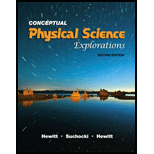
What is the difference between an element and a compound?
The difference between an element and a compound
Answer to Problem 17RQ
The material which consists of only one type of atoms is called an element and it is compound if it consists of different type of atoms in a fixed ratio.
Explanation of Solution
Atom is a spherical entity and is the basic constituent of matter. Some substances consist of only one type of atoms and those substances are called elements. For example a piece of pure silver consists of only silver atoms and silver is an element. But water with chemical formula
Conclusion:
Therefore, when all the atoms in a material are same, the material is called an element. A compound consists of elements is fixed and definite proportion.
Chapter 17 Solutions
Conceptual Physical Science Explorations
Additional Science Textbook Solutions
University Physics Volume 1
Glencoe Physical Science 2012 Student Edition (Glencoe Science) (McGraw-Hill Education)
Conceptual Physics (12th Edition)
Applied Physics (11th Edition)
Physics: Principles with Applications
 College PhysicsPhysicsISBN:9781305952300Author:Raymond A. Serway, Chris VuillePublisher:Cengage Learning
College PhysicsPhysicsISBN:9781305952300Author:Raymond A. Serway, Chris VuillePublisher:Cengage Learning University Physics (14th Edition)PhysicsISBN:9780133969290Author:Hugh D. Young, Roger A. FreedmanPublisher:PEARSON
University Physics (14th Edition)PhysicsISBN:9780133969290Author:Hugh D. Young, Roger A. FreedmanPublisher:PEARSON Introduction To Quantum MechanicsPhysicsISBN:9781107189638Author:Griffiths, David J., Schroeter, Darrell F.Publisher:Cambridge University Press
Introduction To Quantum MechanicsPhysicsISBN:9781107189638Author:Griffiths, David J., Schroeter, Darrell F.Publisher:Cambridge University Press Physics for Scientists and EngineersPhysicsISBN:9781337553278Author:Raymond A. Serway, John W. JewettPublisher:Cengage Learning
Physics for Scientists and EngineersPhysicsISBN:9781337553278Author:Raymond A. Serway, John W. JewettPublisher:Cengage Learning Lecture- Tutorials for Introductory AstronomyPhysicsISBN:9780321820464Author:Edward E. Prather, Tim P. Slater, Jeff P. Adams, Gina BrissendenPublisher:Addison-Wesley
Lecture- Tutorials for Introductory AstronomyPhysicsISBN:9780321820464Author:Edward E. Prather, Tim P. Slater, Jeff P. Adams, Gina BrissendenPublisher:Addison-Wesley College Physics: A Strategic Approach (4th Editio...PhysicsISBN:9780134609034Author:Randall D. Knight (Professor Emeritus), Brian Jones, Stuart FieldPublisher:PEARSON
College Physics: A Strategic Approach (4th Editio...PhysicsISBN:9780134609034Author:Randall D. Knight (Professor Emeritus), Brian Jones, Stuart FieldPublisher:PEARSON





